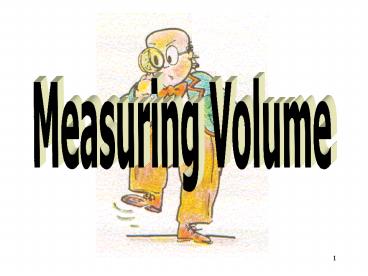Measuring Length, Area - PowerPoint PPT Presentation
1 / 20
Title:
Measuring Length, Area
Description:
* Measurement of Volume Volume is the amount of space an object takes up. * Volume Tools Regular Shaped Objects (an object that is a quadrilateral) Ruler Tape measure ... – PowerPoint PPT presentation
Number of Views:408
Avg rating:3.0/5.0
Title: Measuring Length, Area
1
Measuring Volume
2
Measurement of Volume Volume is the amount of
space an object takes up.
3
Volume Tools
- Regular Shaped Objects
- (an object that is a quadrilateral)
- Ruler
- Tape measure
- Meter stick
- Irregular Shaped Objects
- Graduated Cylinder
- Beaker
- Flask
4
Volume of a Regular Shaped Object
- Volume Length x Width x Height
- V LxWxH
- To find the volume of a regular shaped object (an
object that is a square or rectangle), place a
ruler on all three sides of the square and
measure
5
Length Long (side to side) Width Thick
(wide) Height Tall (up down)
6
UNITS!!!
- The measure of a regularly shaped object will
typically be in the following units - m3
- cm3
- mm3
7
Practice 1
Volume Length x Width x Height
Volume 20 m x 2 m x 2 m
80 m3
8
Practice 2
Volume Length x Width x Height
Volume 10 m x 4 m x 5 m
200 m3
9
Volume of an Irregular Shaped Object
- To find the volume of an irregularly shaped
object (an object where the sides are not all
flat), use a beaker or a graduated cylinder.
10
How to Measure the Volume of an Irregular Shaped
Solid
- Fill the graduated cylinder with enough water to
cover object. Record the volume - Carefully place the object into the water filled
graduated cylinder. - Record the new water level.
- The volume of the object is the Final Volume
Initial Volume
11
UNITS!!!
- The measure of a irregularly shaped object will
typically be in the following units - mL
- Liters
12
Tips to Reading a Graduated Cylinder
- Find the two nearest numbers on a G.C
- 2. Subtract them
- Then divide by the number of spaces (not lines!)
13
Meniscus reading When you pour water into a
measuring cylinder and place it on the bench or
any flat surface, you will observe that the water
surface is curved. The meniscus of most liquids
curves downwards. The correct way to read the
meniscus is to position the eye at the same level
as the meniscus.
14
The mark corresponding to the bottom of the
meniscus is taken as the reading.
What does this Meniscus read? This should read
8.6 mL
15
When taking readings from the measuring cylinder,
the bottom of the water meniscus was read
horizontally at the eye level to avoid parallax
error.
16
Volume of a liquid
- Formula
- Read the volume level from the bottom of the
meniscus
17
Measuring the volume of a large irregular-shaped
object 1. Fill the displacement can with water
until excess water flows out of its spout
into a beaker. Remove the beaker when water
stops flowing into it.
18
2. Place an empty measuring cylinder below the
spout of the displacement can. Tie
the irregular-shaped object with a piece of
string. Lower it gently into the can until it
is completely immersed in the water.
19
3. When the water stops flowing into
the measuring cylinder, observe and record the
volume of water displaced by the object and
collected in the measuring cylinder. The volume
of the water in the measuring cylinder is
equal to the volume of the irregular-shaped obje
ct.
20
THE END

